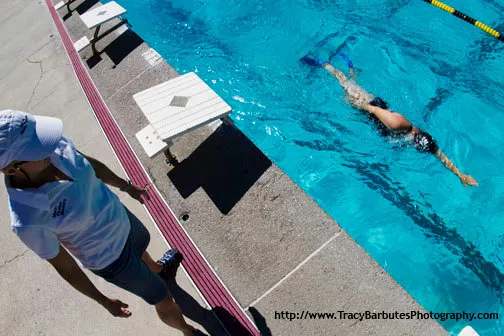The concepts of a swimming drill may sound intimidating, but it doesn’t have to be.
A drill is merely a specific exercise that focuses on a particular aspect of a swim stroke.
And by using a logical sequence of swimming drills, you can learn a new stroke without the struggle.

(Photo: Tracy Barbutes)
Swimming drills also allow you to improve your swimming technique significantly.
Why practice swim drills?
First of all, the movements you do while practicing drills are often different than the ones you do during regular swimming, and especially so with the initial drills.
This ensures that previously learned bad habits don’t interfere while (re-)learning a swimming stroke.
Those drills also teach you how to use your senses to feel how to do the correct movements rather than having to think them intellectually.
This is not unlike how martial arts are taught to students.
A swimming stroke is broken down into its components, and each component is practiced repeatedly until your body knows how to move correctly.
Once this understanding has occurred, your body will automatically try to reproduce the same sensations and movements during practice, and your mind is free to take on the next challenge.
This also means that there is a logical ordering of the skills to be learned.
During each sequence of swimming exercises, you are presented with more and more difficult challenges to solve.
But as your body adapts and integrates new skills, you become ready to tackle the next drill.
The purpose of each drill is to master a specific skill. Tackling one skill at a time ensures that you don’t become overwhelmed and can fully concentrate on the task at hand.
Progress occurs faster and is easier to evaluate. Once you have mastered a specific swimming drill, you are ready to progress to the next one without too much difficulty.
But if you move to the next drill without mastering the current one, you might run into problems.
Finally, the practice of drills has a zen-like quality.
While you are focusing on the movements and sensations experienced during practice, you will notice how you can be both relaxed and concentrated on the task at hand while floating in the water.
Swimming then becomes like a moving meditation in the water that can be quite enjoyable.
How to practice swimming drills
The key to successfully learn the different drills is to practice them patiently in the suggested order.
It will often take a couple of swim sessions to be able to execute a new drill correctly.
This means it should take a couple of weeks to master the set of drills specific to each swimming stroke.
Nevertheless, you should quickly notice that your swimming technique improves once you add the practice of drills into your workouts.
So don’t try to complete all the swimming drills specific to a particular swimming stroke in only a few swim sessions.
It is best to take your time and to start each swim session by rehearsing a few drills you already know.
This allows you to get into the zone, and you are then ready to practice one or two new drills.
Once you have practiced your drills, you can move on to something else, for example, lap swimming.
Ideally, you should only start a new drill when the previous one has been mastered.
This gives the body time to adapt between swim sessions. You should notice that rehearsing a drill becomes easier with each new swim session, as the body has adapted.
Finally, you are ready to move to the next drill.
You can also work on more than one swim stroke at a time so that you progress simultaneously with several swim strokes.
It is also important that you take your time and enjoy the process of steady improvement made possible through relaxed yet focused practice.
Additional Tips for Practice
Once you have mastered a swim stroke, it still is beneficial to rehearse its corresponding swimming drills regularly.
For example, you can alternate lengths of drills with lengths of regular swimming.
Or you can practice a drill for a few lengths, focusing on a specific aspect of your technique, and then try to maintain that focus while swimming a few regular lengths.
Finally, alternating regular swimming with swimming drills keeps your workouts more varied and interesting.
Conclusion
Now that we have discussed why swimming drills are among the best tools to learn swimming or to improve your technique, you can visit the following pages that contain specific drills for each swimming stroke:
- Learn To Swim Front Crawl
- Learn To Swim Breaststroke
- Learn To Swim Backstroke
- Learn To Swim the Butterfly Stroke
- Learn To Swim Sidestroke
Have fun and enjoy swimming!

Marie
Friday 20th of July 2018
Hi,
I think this questioned has been asked before but I couldn't find it. How often should each of the drills be practiced before progressing to the next one?
Thank you!
Christophe
Friday 20th of July 2018
Hi Marie,
I'd say you should practice a drill until you can execute it in a relaxed or at least controlled manner.
You may try to move to the next drill earlier, but you might get stuck if a prerequisite from an earlier drill hasn't been mastered.